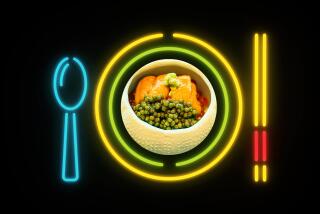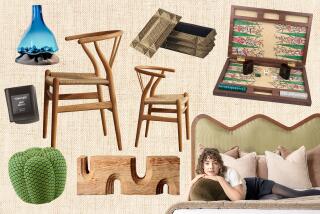FURNISHINGS : China’s a Fine Way to Make Holiday Dinners Special
A long time ago, way before those little perforated cartons of cereal were invented, inhabitants of the civilized world sat down to their meals before lace-encrusted tables and gorged themselves on joints of beef with utensils made of silver.
And though paper plates, Styrofoam cups, and plastic knives and forks have crept onto the American dining table like insects, silver is still with us. It’s in a drawer in the buffet cabinet, about to be dusted off and polished for the holiday dinner party season.
But, except maybe at this time of year, nobody entertains at home any more. It’s easier to swallow the huge expense of reserving a table for 12 at a restaurant and have the staff deal with the food and the formalities, and let everyone (sometimes even the waiter) go home feeling gypped.
Chalk it up to the death of the servant class, or that women spend more time running their careers and less time running around in the kitchen. In a perfect world, their husbands would do that, but they’d still probably be left with the job of selecting china patterns.
“People definitely judge a household by what they see when they sit down,” says Sarah Hanley, a manager at Villeroy and Boch whose South Coast Plaza outlet specializes in fine china. “It’s a presentation of the host’s personality.”
Hanley says setting a beautiful table doesn’t have to be a lofty pursuit limited to the pages of a Jane Austen novel or White House state dinners. By shedding their grandmother’s inhibitions, most people can manage to conjure the proper ambience for about what it cost to feed those 12 hungry people. And they’ll score points for tradition.
Hanley’s goal is to set free the average homemaker imprisoned by wedding gift china so fancy she is terrified to use it.
“People tend to be ultra-conservative when they venture out to buy china and silver for the first time. It doesn’t have to be that way,” she says. “And the china you use doesn’t have to be made of bone, and the silver can be stainless steel.”
Part of Hanley’s job is to administer protocol to her customers at Villeroy and Boch. There she finds herself carefully adopting the role of Miss Manners while advising her customers on the correct number of forks to use for a three-course meal as opposed to a five-course meal, and when and if finger bowls (a dying icon, at best) are necessary. All of this in a world where slamming down a hamburger while steering onto the San Diego Freeway is the accepted norm of taking a meal.
Of course, the dinner party used to serve as the primary excuse for exhibiting one’s social status.
“Victorian women had over 1,800 pieces of silver on the table at one time,” says Mary Reynolds, a sales associate at South Coast Plaza’s exclusive sterling and crystal store, Lucy Zahran Inc. Among them: a sterling lettuce fork for serving individual pieces of lettuce; a sterling corn scraper; a special spoon for pudding; an elongated spoon for reaching into canisters of horseradish--maybe even a knife rest, “so they wouldn’t always have to wash out those big linens,” Reynolds says.
But the rules for setting a table have changed somewhat to keep up with the microwaveable social graces of the late 20th Century.
“The trend is toward more formal entertaining,” says Helen Russell, manager at the Lenox China Store in South Coast Plaza. “New tableware can be combined with family heirlooms to create an understated elegance that is nostalgic in mood.”
Hanley says you should start with the basics: white dinner plates are a good background, to which can be added different patterns to suit different occasions. Bone china is always the most formal, she says, but a good porcelain is also a good bet. “And don’t be afraid of trim,” Hanley advises. “There’s nothing wrong with trim.”
So if that sounds like a manageable pursuit, here are the five basic pieces that Hanley says comprise the well-healed place setting: the basic dinner plate, the salad plate, a teacup and saucer, a bread and butter dish and a soup bowl that doubles as a cereal bowl.
Reynolds suggests these flatware complements: dinner forks, butter knives, salad forks, soupspoons and teaspoons.
Extras may include open vegetable-salad bowls (Hanley suggests keeping at least two on hand); a gravy boat (although gravy is a bit of a dinosaur in these cholesterol-conscious times); an oval or round platter (for those big productions, like the one you’re contemplating for Christmas dinner); sandwich trays (for buffets); and cake plates (“cakes look nicer on a pedestal”). There are also butter dishes and margarine pots, egg cups, napkin rings, ad infinitum.
And there are many choices when it comes to bowls. The basic soup (and cereal), the rimmed soup bowl, the cream soup bowl, a bowl for fruit, custard, rice and eggs. “Bowls can be very confusing,” Hanley says.
Even if most of your dinnerware is made up of florals or some other bold pattern, Hanley says pieces can always be added to change the look of your table, to dress it up or down. By mixing and matching colors and patterns, the dining table is never static, and, as the best chefs know, you’ll never serve the same dish twice.
“By the time you reach dessert, you’ll have a whole new set,” she says.
Jackie Kennedy knew this stuff. Once when entertaining at a state dinner given at Mount Vernon in 1961 in honor of the president of Pakistan, she switched the stiff white damask linen for pale yellows and blues. How nice for her guests, who were charmed by the warmer tones and probably digested everything much more peaceably.
“In today’s fast-paced lifestyles, people treasure the moments they have to just sit with friends and have a good dinner,” Reynolds says. “We’re all tired of restaurants. The time we spend together is going to be quality time.”
When shopping for place settings, Hanley suggests keeping in mind the following rules of etiquette: the flatware is placed 1 inch from the edge of the table at place settings that are equidistant from each other (about 30 inches between centers of plates). The napkin may be placed on the plate, unless the first course is in place, in which case it is to the left of the forks. There should never be more than three utensils on each side of the plate, and always place the utensil that is to be used first on the outside. “You should be able to predict what the meal will be from your place setting,” Hanley says.
The average cost for each place setting runs between $60 and $150 at Villeroy and Boch (Hanley suggests buying service for eight,) and a five-piece set of sterling silver flatware at Lucy Zahran ranges from $200 to $1,000. “Silver is still the first thing a cat burglar goes for,” Reynolds says, which would seem to make a good case for stainless steel, available at housewares stores, such as the Pottery Shack in Laguna Beach. They also sell less formal china, stemware and napkins. A five-piece set of stainless runs from $20 to about $60.
“Most brides are doing silver-plated at around $175 for a five-piece set,” Reynolds says. She adds that the high price of silver is based more on the quality of workmanship involved than its market price.
“There are a limited amount of artisans--most of them are old and there are few young people coming in to replace them,” she says. In a cabinet on the shop’s mezzanine, Reynolds points out a grouping of the French Christofle silver-plated flatware, consisting of more than 50 different types of utensils, including something called an ice cream knife. All of the forks are facing down, a custom that is in sync with the European habit of eating with the fork held in the left hand, tines pointing earthward.
“Europeans don’t eat like we do,” Reynolds says. “You can’t shovel your food in if you hold your fork that way. Try it.”
A few more guidelines on choosing place settings:
* Be stylish and ephemeral; don’t be afraid to mix and match patterns.
* Most spills occur because plates are too small. Hanley suggests using plates 18 inches in diameter.
* Paper napkins are an effrontery, especially indoors.
* White is always right. On the other hand, black is considered quite sophisticated.
* Remember: crystal goes with everything. And some of it is even microwaveable.


